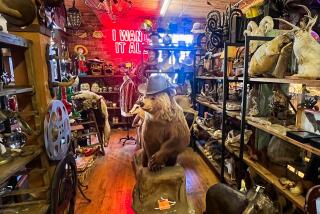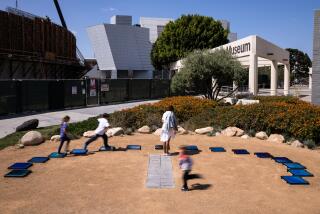Academy Museum names historian of Black cinema as the new chief artistic officer
The Academy Museum of Motion Pictures is expected to announce Monday that Jacqueline Stewart will be its chief artistic and programming officer, overseeing exhibitions, programming and education.
Stewart is a prominent film historian, scholar and archivist who teaches American film history at the University of Chicago; her specialty is in African American cinema. She was the first Black host of Turner Classic Movies’ “Silent Sunday Nights,” which spotlights silent films.
Stewart will join the museum in January before its public opening, scheduled for April 30. She plans to ensure that the museum approaches the areas she oversees “with a really clear, coherent storyline,” as she explains in this edited conversation.
What’s that storyline? Do you have an overall vision for the museum?
This is a museum that is really going to give a 360-degree view of moviemaking. So for me, it’s really about guiding the ways that the museum will continue to, over time, provide a broad sense of film history. That it is not entirely focused on Hollywood, that it expands beyond some of the conventional, traditional ways that film history has been narrated and that it really draws on the wide range of expertise located in Los Angeles. And including as many voices as possible, that we never drop the ball on that in any aspects of the museum’s work.
“What the Constitution Means to Me” author Heidi Schreck interviews Norman Lear as her play about women’s rights, or lack thereof, hits Amazon Prime.
You’ve said that cinema shapes our understanding of history and culture and that movies spark dialogue. How will you guide the Academy Museum to help fulfill this mission?
The very large-scale “Stories of Cinema” exhibition — there is already careful attention to the work of women filmmakers, the work of filmmakers of color, and that will be an essential aspect of the experience that people have when they’re moving through the museum. I’m very excited too to develop museum experiences that happen virtually. Right now, so many cultural institutions have had to pivot into virtual programming. This is a museum that will always have a really singular in-person experience, but we’re going to marry that with virtual experiences. Not just for public health reasons but in the interest of being as broadly accessible as possible.
You were on the advisory committee for the museum’s “Regeneration: Black Cinema 1898-1971” exhibition, which was planned years ago. Have the COVID-19 pandemic and subsequent racial justice movement reshaped it at all?
In terms of content, no, it hasn’t changed. The goal that the curators, Doris [Berger] and Rhea [L. Combs] have for that exhibition, we’re seeing now just how deeply resonant and relevant it is — all of these efforts that African American filmmakers have made to try to affirm Black lives, to try to speak to the erasure and misrepresentation of Black lives in mainstream media. The great care they have taken to find objects and to even have a scope as wide as the exhibition does, from the late 1890s all the way to 1971, it’s going to show us these waves of Black filmmaking, particularly independent Black filmmaking, that I think are going to be inspiring to people in the way that we want the museum to be inspiring to people, to cultivate the next generation of filmmakers, to make it impossible to ignore some of the chapters from the past and take them into account for the future.
Have you learned anything as a host on Turner Classics Movies that you’ll apply to the Academy Museum?
Absolutely. We live in a kind of deeply media [savvy] society. At TCM, there’s an extraordinary community of fans who have so much knowledge of film history. We see it on social media platforms, our festival. People have such a passionate attachment to movies and a lot of expertise. So one of the things I’m excited about at the museum is that the interaction won’t just be one way. The visitors will be there, and it’s an incredible opportunity to give people voice, to give them moments when they can ask questions and share their thoughts. The museum won’t just be speaking to them, but they can speak to us and each other.
What kind of programming might you develop around silent movies?
I’m a little hesitant to describe specific programming because it’s early. But what I can say is that silent film, experimental film, amateur films, there are so many areas of film production that have not gotten their proper due. For silent film, these are the films that function as the blueprint for the films that we enjoy today. So early cinema, silent cinema, these are really important chapters of film history that we will cover extensively at the museum.
Several museums are collecting pandemic-era ephemera. Have you thought how the Academy Museum might capture this strange moment we’re in from a film standpoint?
This has been a hugely transformative moment in public life in general and in media and entertainment industries quite broadly. And it’s going to be important for us to pay attention to the ways that the industry responds. What happens to film distribution? What happens when actors can’t interact with each other on-set and on-screen in the same ways? This COVID era of film production, I can see this making an incredibly interesting exhibit 10 or 15 or 25 years from now.
What might that look like?
It could make a really interesting documentation oral history project. Just putting together the story of how the industry dealt with this disruptive, tragic moment.
The movie theater business has been in crisis for years now, with more people streaming movies at home and watching entertainment on mobile devices. The pandemic accelerated the trend by closing theaters. Does that concern you, seeing as the Academy Museum’s crown jewel is its 1,000-seat spherical theater?
I can say I’m disappointed, for sure. As someone who regularly screens films across the South Side of Chicago, and has done that over the course of my career, it’s devastating not to be able to do that. It’s been a huge part of my scholarly practice to show films and then have conversations with people. Having said that, though, we’re all in the same boat, we’re all being impacted by this, people who study and present films. And we’ve had to pivot and figure out different ways to watch films and talk about them, moving them to virtual spaces. We’ll just have to pay close attention to the safest way to do things and recognize that we’re part of a larger film community trying to address this set of issues and do the best we can until we can get to the capacity that we originally envisioned.
The Lucas Museum of Narrative Art this year acquired more than 37,000 items documenting African American cinema history. Given some of the parallels between the two museums, have you thought about joint initiatives and programming?
Absolutely. That’s a natural. When the “Regeneration” exhibition opens at the Academy Museum, there will be such powerful ways we can connect the dots and get people to see just the wealth of creative work African Americans have been doing on film. Even those things that seem to be just so relentlessly stereotypical, there are aspects of performance and there are social and political dimensions of those representations that we really need to bring to light and to understand in more nuance. That kind of partnership will be so generative.
What are you most excited about in this new position?
There are so many things — I’m just closing my eyes here. I’m most excited about the scale of the museum. This, for me, is an opportunity to take all of the research and the teaching and the archival work that I’ve done and three-dimensionalize it and really make it live for people in ways that are unpredictable.
Radha Blank’s ‘Forty-Year-Old Version’ on Netflix highlights racism in the theater industry. We asked 40 Black theatermakers for their stories.
More to Read
The biggest entertainment stories
Get our big stories about Hollywood, film, television, music, arts, culture and more right in your inbox as soon as they publish.
You may occasionally receive promotional content from the Los Angeles Times.








